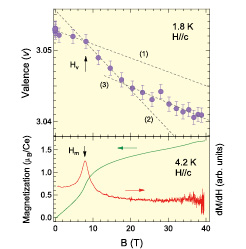Partial Kondo Breakdown in CeRu2Si2 at High Magnetic Fields
Y. Matsuda Group
Most of the heavy fermion (HF) systems contain Ce or Yb. The occupation number of the 4f electron in the orbital (nf) is close to 1 for Ce, and in Yb, the occupation number of the 4f hole (nh) is close to 1. The 4f electrons acquire an itinerant character because of the strong hybridization with the conduction electrons. The energy level of the correlated 4f electrons is near the Fermi energy, because the significant electron-electron many-body interaction causes the electrons to become itinerant HFs. The degree of the itinerancy is determined by the strength of the electron interaction. The itinerant character manifests itself in the deviation of the occupation number of the f electron or hole from unity: nf or nh. In HF systems, 1 – nf (1 – nh) must be very small but finite, indicating that the electrons are highly localized and only slightly itinerant.

Fig. 1. (a) Magnetic field dependence of the Ce valence at 1.8 K. The dashed lines (1), (2) and (3) show the slope of the valence change in low, medium and high magnetic field ranges, respectively. The arrow denotes the characteristic magnetic field Hv for the valence change (b) Magnetic field dependence of the magnetization (M) and the field derivative (dM/dH) at 4.2 K. The arrow denotes the metamagnetic transition field Hm.
The valence state of Ce in a canonical heavy fermion compound CeRu2Si2 has been investigated by synchrotron X-ray absorption spectroscopy at 1.8 K in high magnetic fields of up to 40 T. It was found that the valence was slightly larger than for the pure trivalent state (Ce3+: f 1), as expected in heavy fermion compounds, and it decreased toward the trivalent state as the magnetic field was increased.
In Figure 1 (a), the valence is plotted as a function of magnetic field, and the magnetization (M) and its magnetic field derivative (dM/dH) at 4.2 K are shown as a function of the magnetic field in Fig.1 (b) for comparison. In the M and dM/dH curves, the metamagnetic transition is clearly visible at the transition field of 8 T (Hm). An unusual magnetic field dependence of the valence was found in the field variation of the valence. The valence decreased slightly in low magnetic fields and the rate of the decrease was larger when the magnetic field was higher than about 8 T; this magnetic field was defined as Hv. It was clear that Hv corresponded to the metamagnetic transition field, Hm. The valence gradually decreased and continued to change even at magnetic fields higher than Hm. The valence decreased even at 40 T, although the metamagnetic transition was probably complete above 20 T.
If a complete field-induced valence transition takes place, Δnf /1-nf should be close to 1.0. It is actually about 0.7 in the Yb-based heavy fermion compound, YbAgCu4. [1] The value of Δnf /1-nf obtained in the present work is 0.012 / 0.053 ~ 0.23, suggesting that the itinerancy of the f electrons is suppressed but the f electrons were still in far from the complete Kondo breakdown even at the 40-T magnetic fields.
References
- [1] Y. H. Matsuda, T. Nakamura, J. L. Her, K. Kindo, S. Michimura, T. Inami, M. Mizumaki, N. Kawamura, M. Suzuki, B. Chen, H. Ohta, and K. Yoshimura, J. Phys. Soc. Jpn. , 015002 (2012).
